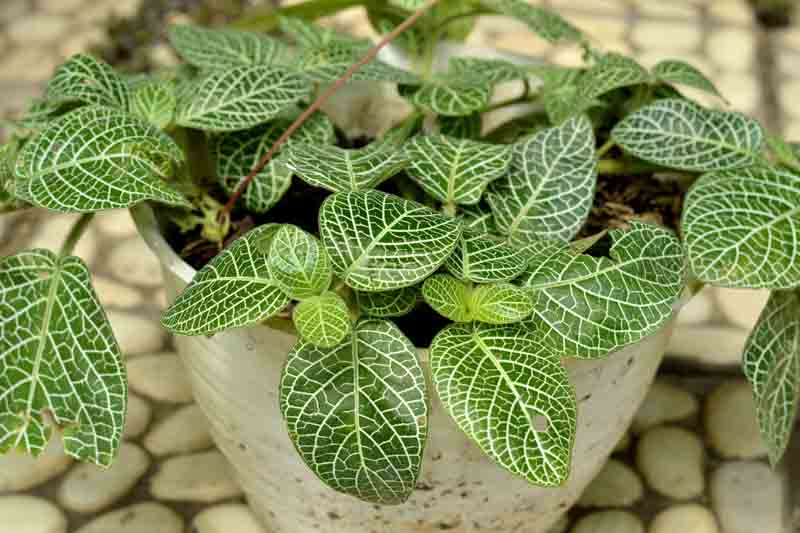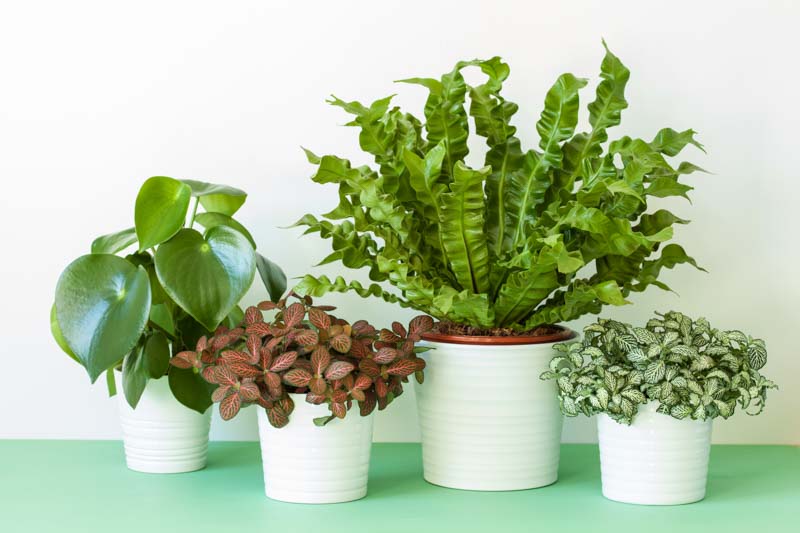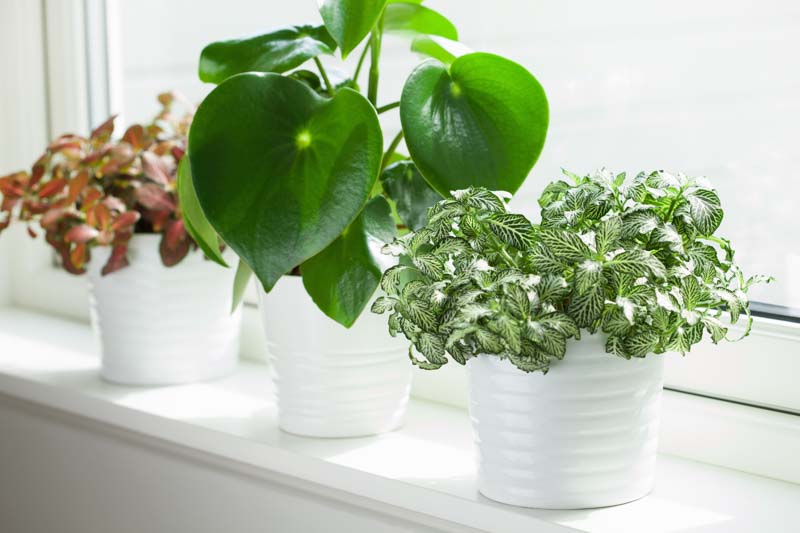Jewel Plant, Mosaic Plant, Nerve Plant, Silver Nerve, Silver Nerve Plant, Silver Threads, Fittonia argyroneura
Fittonia albivenis, commonly known as the Nerve Plant or Mosaic Plant, is a strikingly beautiful, low-growing plant famed for its vibrant leaf veining and lush foliage. It is a popular choice for indoor gardeners and terrarium enthusiasts alike.
Fittonia albivenis is renowned for its rich, green leaves adorned with intricate veins of white, pink, or red, giving it a unique and decorative appearance. The leaves are soft, with a slightly velvety texture, adding to its visual appeal.
Native: This plant is native to the tropical rainforests of South America, particularly Colombia, Peru, Bolivia, Ecuador, and northern Brazil. It thrives under the canopy of the forest floor, which informs its care and cultivation conditions. It belongs to the acanthus family (Acanthaceae), along with the Bear’s Breech, Persian shield, and the Polka Dot Plant.
Plant Type and Habit: The Nerve Plant is a creeping evergreen perennial that grows as ground cover in its natural habitat. Due to its compact growth habit, it’s often used in terrariums or as a tabletop plant in home environments.
Size: It typically reaches a height of 5 to 8 inches (12 to 20 cm) and spreads outwards to about 12 to 18 inches (30 to 45 cm), forming a dense mat of foliage.
Flower: While it does occasionally bloom, producing small, white, or yellowish flowers, the flowers are not particularly showy compared to its foliage. Bloom time is generally in the summer, but indoor plants rarely flower.
Foliage: The most notable feature of Fittonia albivenis is its foliage, with its contrasting silvery veins creating a stunning visual display. The broadly elliptic leaves can vary in color based on the variety.
Hardiness: It is not frost-tolerant and thrives in warm, humid environments typical of USDA hardiness zones 11 and 12.
Award: Recipient of the prestigious Award of Garden Merit of the Royal Horticultural Society.
Uses: The Nerve Plant is primarily used for decorative purposes, especially in terrariums and dish gardens, and as an underplanting for larger indoor plants. Its ability to thrive in low-light conditions makes it a versatile choice for indoor landscaping.
Toxicity: Fittonia albivenis is considered non-toxic to pets and humans, making it a safe choice for households with pets and children.
Benefits: Apart from its ornamental value, Fittonia albivenis can contribute to improving indoor air quality by filtering out pollutants, though this benefit is generally modest compared to its visual appeal.

Growing and caring for the Nerve Plant can be a rewarding experience, thanks to its stunning foliage and compact growth habit. Here are key tips to help you successfully nurture this beautiful indoor plant:
Light: Fittonia albivenis prefers bright, indirect light. It can tolerate lower light conditions, but its vibrant leaf coloration and patterns may fade. Direct sunlight should be avoided to prevent leaf scorch. A spot near a window with sheer curtains is ideal.
Soil: Use a well-draining, peat-based potting mix.
Water: Keep the soil consistently moist but not waterlogged. Water the plant when the top inch of soil feels dry to the touch. Fittonia is sensitive to drought, so don’t let the soil dry out completely.
Temperature and Humidity: Maintain indoor temperatures between 60-80°F (15-26°C). Fittonia is not cold-hardy and should be protected from drafts and sudden temperature drops. This plant thrives in high-humidity environments, mimicking its natural tropical habitat. Regular misting, placing it in a pebble tray with water, or using a humidifier can help meet its humidity needs.
Fertilization: Fertilize your Nerve Plant every 2-4 weeks during the growing season (spring and summer) with a balanced, liquid fertilizer diluted to half the recommended strength. Reduce feeding in the fall and winter months.
Pruning: Prune back any leggy growth to encourage a bushier plant. Regularly remove any yellowed or dead leaves to keep the plant healthy and attractive.
Repotting: Repot in the spring if the plant has outgrown its pot or the soil needs refreshing. Choose a pot only slightly larger than the previous one to avoid excess soil moisture.

Propagating the Nerve Plant is a straightforward process that can be done using stem cuttings, ensuring a new generation of these vibrant, veined beauties for your home or office. Here’s how to propagate your Nerve Plant effectively:
Select and Cut: Choose healthy, non-flowering stems for propagation. Using clean, sharp scissors or pruning shears, cut a 4-6 inch piece from the tip of the stem. Ensure each cutting has at least 2-3 leaf nodes (the points where leaves attach to the stem).
Prepare Cuttings: Remove the leaves from the bottom half of each cutting to expose the nodes. This area is where roots will form. You can dip the cut end into rooting hormone to encourage root growth, but this is optional.
Plant Cuttings: Fill small pots or containers with a well-draining potting mix. Plant the cuttings about an inch deep into the soil, ensuring at least one node (preferably two) is buried where roots will develop.
Create Humidity: To maintain high humidity around the cuttings, which helps in root formation, you can cover the pots with clear plastic bags. Make sure the bag doesn’t touch the leaves by propping it up with sticks or similar. Open the bag daily for fresh air circulation.
Water and Wait: Water the cuttings lightly to keep the soil consistently moist but not waterlogged. Place the pots in bright, indirect light. Avoid direct sunlight, which can be too intense.
Root Development: In about 2-4 weeks, roots should begin to develop. You can gently tug on the cuttings to feel for resistance, indicating root growth.
Aftercare: Once the cuttings have established roots and show new growth, you can remove the plastic bags (if used) and care for them as mature plants. Continue to keep them in indirect light and maintain soil moisture.

While generally easy to care for, the nerve plant can encounter pests, diseases, and common problems.
Spider mites: These tiny pests can cause yellowing and drop of leaves by sucking on the undersides. Increase humidity and use insecticidal soap to combat them.
Mealybugs: Recognizable by their cotton-like white masses, they suck plant sap, weakening it. Remove them manually using a cotton swab dipped in rubbing alcohol or apply insecticidal soap.
Scale insects: These can appear as small brown bumps on the stems and leaves, sucking the sap and reducing plant vigor. Scrape them off or treat them with neem oil.
Root rot: Overwatering is the primary cause, leading to brown, mushy roots. Ensure proper drainage and let the soil dry slightly between waterings.
Leaf spot diseases: Caused by fungal or bacterial infections, presenting as discolored spots on leaves. Improve air circulation and avoid wetting the foliage when watering.
Browning Leaf Edges: Often due to low humidity or underwatering. Mist regularly, use a pebble tray, or place a humidifier nearby to increase humidity.
Leggy Growth: Insufficient light can cause sparse, leggy growth. Move your plant to a brighter location with indirect light to encourage fuller growth.
Fading Leaf Color: A sign of too much direct sunlight. Fittonia prefers bright, indirect light. If exposed to direct sun, relocate to a shadier spot.

Water your Fittonia (Nerve Plant) approximately once a week, ensuring the soil stays evenly moist but not waterlogged. The frequency can vary based on environmental conditions like temperature and humidity. In dryer conditions, it may need more frequent watering, while in more humid environments or during winter, less frequent watering might be necessary. Always check the top inch of soil for dryness before watering again.
Nerve Plants prefer bright to medium, indirect sunlight. Direct sunlight can scorch their delicate leaves, while too little light may cause them to lose their vibrant colors and become leggy. A location near a window with filtered light or a spot that receives ample indirect light throughout the day is ideal.
Fittonia is not particularly hard to care for, but it does require consistent attention to its needs to thrive. Its requirements for high humidity, consistent soil moisture, and avoidance of direct sunlight mean it needs a bit more attention than some more drought-tolerant or low-light plants. With the right conditions, however, Fittonia can be a rewarding and beautiful plant to grow.
Yes, Fittonia naturally spreads and can create a lush, dense mat of foliage over time. It’s a creeping plant that extends outward through its stems, making it an excellent choice for ground cover in terrariums or as a decorative indoor plant. You can encourage more compact growth and prevent legginess through regular pruning, which also promotes a fuller appearance.
| Hardiness |
11 - 12 |
|---|---|
| Plant Type | Houseplants, Perennials |
| Plant Family | Acanthaceae |
| Exposure | Partial Sun, Shade |
| Season of Interest |
Spring (Early, Mid, Late) Summer (Early, Mid, Late) Fall Winter |
| Height |
5" - 8" (13cm - 20cm) |
| Spread |
1' - 2' (30cm - 60cm) |
| Spacing |
12" - 18" (30cm - 50cm) |
| Maintenance | Low |
| Water Needs | Average |
| Soil Type | Loam |
| Soil pH | Neutral |
| Soil Drainage | Moist but Well-Drained |
| Characteristics | Showy, Evergreen, Plant of Merit |
| Garden Uses | Patio And Containers |
| Hardiness |
11 - 12 |
|---|---|
| Plant Type | Houseplants, Perennials |
| Plant Family | Acanthaceae |
| Exposure | Partial Sun, Shade |
| Season of Interest |
Spring (Early, Mid, Late) Summer (Early, Mid, Late) Fall Winter |
| Height |
5" - 8" (13cm - 20cm) |
| Spread |
1' - 2' (30cm - 60cm) |
| Spacing |
12" - 18" (30cm - 50cm) |
| Maintenance | Low |
| Water Needs | Average |
| Soil Type | Loam |
| Soil pH | Neutral |
| Soil Drainage | Moist but Well-Drained |
| Characteristics | Showy, Evergreen, Plant of Merit |
| Garden Uses | Patio And Containers |
How many Fittonia albivenis (Nerve Plant) do I need for my garden?
| Plant | Quantity | |
|---|---|---|
| Fittonia albivenis (Nerve Plant) | N/A | Buy Plants |
Create a membership account to save your garden designs and to view them on any device.
Becoming a contributing member of Gardenia is easy and can be done in just a few minutes. If you provide us with your name, email address and the payment of a modest $25 annual membership fee, you will become a full member, enabling you to design and save up to 25 of your garden design ideas.
Join now and start creating your dream garden!
Create a membership account to save your garden designs and to view them on any device.
Becoming a contributing member of Gardenia is easy and can be done in just a few minutes. If you provide us with your name, email address and the payment of a modest $25 annual membership fee, you will become a full member, enabling you to design and save up to 25 of your garden design ideas.
Join now and start creating your dream garden!